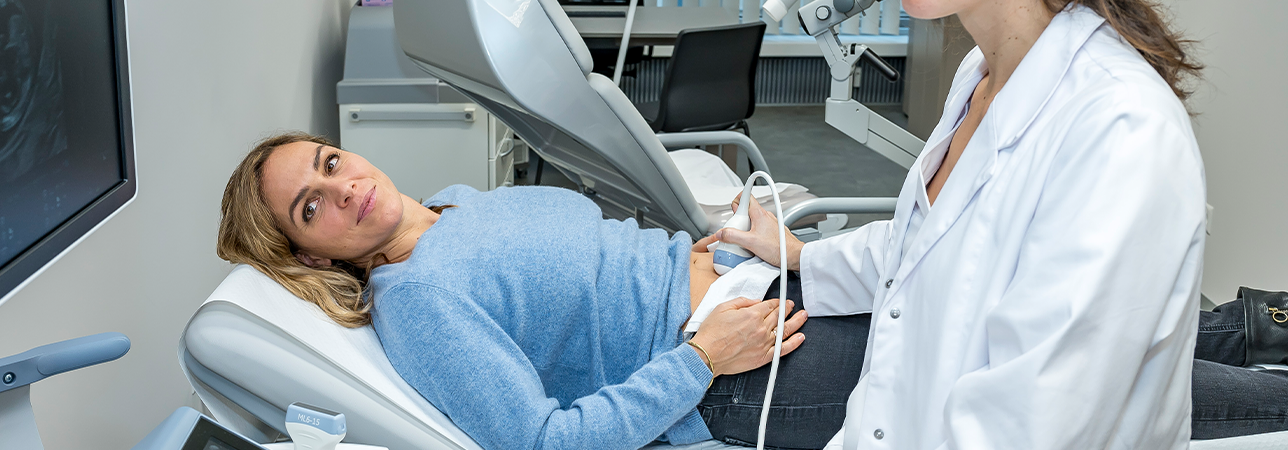
Endometriosis
Endometriosis is one of the most common abdominal diseases in women, where cells are similar to those of the uterine mucous membrane outside the uterine cavity. It can lead to severe pain and even infertility before and during a woman’s period.
It usually takes many years before endometriosis is identified as the cause of the pain. Until then, many of the affected women try to cope in some way with their symptoms and the associated (physical) impairments, as they believe that even the most severe pain is «normal» and is part of the menstrual period.
Quick Facts
- Definition: Endometriosis occurs when cells similar to those of the uterine lining grow outside the uterine cavity.
- Symptoms: Endometriosis can cause severe pain and may even lead to infertility.
- Causes: The exact causes of endometriosis remain largely unclear. Hormonal factors, the immune system, and genetic predisposition are thought to play a role.
- Treatment: Treatment is recommended in cases of severe, life-impacting symptoms. Options include surgical removal or ablation of affected tissue, removal of the fallopian tubes or uterus, or the use of specific hormone therapies or contraceptives that suppress menstruation and reduce the influence of female sex hormones on endometriotic lesions.
The illness: endometriosis
In endometriosis, cells that resemble the uterine mucosa «get lost» in the body and settle in the «wrong place», for example, in the pelvis, ovaries, bladder or intestines. These patches of lost tissue, or endometriosis lesions, can occur without the woman feeling any of them.
In other women, however, endometriosis develops into a chronic (i.e. slowly developing, slowly progressing, prolonged) disease that can cause severe pain and even reduce fertility, which is why endometriosis is now regarded as one of the main causes of infertility.
Symptoms
Endometriosis can go completely unnoticed. This is mainly due to the fact that it causes few symptoms in some women, but in others it causes such severe pain that their quality of life is increasingly impaired.
The most characteristic sign of endometriosis is recurring abdominal pain, the intensity of which typically fluctuates over the course of the month. In most cases, the symptoms reach their peak shortly before or during a woman’s period.
Other possible symptoms include:
- Severe, often spasmodic pain for the duration of the period
- Recurrent pain in the lower abdomen
- Heavier periods
- Bleeding between periods
- Abdominal and back pain
- Pain during or after sexual intercourse
- Pain during gynaecological examinations
- Pain or problems with bowel movements or urination
- Bleeding from the bowel or bladder
- Flatulence, diarrhoea or constipation
- Persistent pain, regardless of menstruation
- Infertility
However, all these symptoms may have other causes, which makes the diagnosis of endometriosis considerably more difficult. In addition, the nature and
severity of the symptoms vary depending on where in the female body the mucosal cells have mistakenly settled.
Causes
The uterine mucosa (endometrium) rebuilds in every monthly cycle. If fertilisation fails, the mucous membrane sheds and the period begins.
Endometriosis lesions behave in the same way as the uterine mucosa, i.e. grow in the first half of the menstrual cycle and are shed again in the second half.

The problem is that the detached tissue of the endometriosis lesions cannot flow out of the abdomen (via the vagina) as is the case with menstrual bleeding. In many women, the body removes this tissue and blood unnoticed and without consequences, but in some women, the tissue residue leads to adhesions, inflammation and cysts (fluid-filled blisters in the tissue) and causes symptoms of varying degrees of severity.
The causes of endometriosis are still largely unknown. In medicine, it is believed that hormones, the immune system and a family predisposition are the cause of this woman’s disease. Normally, the body’s own defences prevent tissue from forming in other parts of the body. In endometriosis, however, this protective mechanism of the body is disturbed.
Diagnosis
It often takes a very long time for endometriosis to be detected. It takes an average of ten years between the onset of the first symptoms and the diagnosis. Women who experience one or more of the aforementioned symptoms are therefore recommended to make an appointment with their gynaecologist as soon as possible. In this case, the first step is to take a medical history. This is followed by a gynaecological examination. The doctor palpates the vagina, abdominal wall and rectum.
This is usually followed by an ultrasound examination through the vagina (known as transvaginal sonography), which may reveal larger areas of endometriosis. If the patient complains of very severe pain and shows a large number of typical symptoms, the gynaecologist usually also orders an ultrasound examination of the abdomen. In addition, an MRI scan is performed (the individual organs can be shown in detail using magnetic resonance or magnetic resonance tomography and many pathological changes can be seen). If bleeding occurs from the bowel or bladder, these organs are also examined by means of a cystoscopy or colonoscopy (known as endoscopy).
If doctors and patients want to be absolutely sure, a laparoscopy is performed. This is an operation in which thin optical instruments are inserted into the abdomen via several small skin incisions. This allows the doctor to take a look inside the abdominal cavity and examine the organs inside for possible endometriosis lesions. In addition, a tissue sample is taken during the laparoscopy, which is later examined in a laboratory and provides information about the actual presence of the disease.
Treatments
If endometriosis does not cause any symptoms to the patient and does not worsen over time, then no therapy is normally required. However, close medical check-ups in connection with pre-diagnosed endometriosis are always advisable.
However, if endometriosis affects the patient’s physical, mental and general well-being, therapy is recommended, whereby the respective treatment method depends on the woman’s age and stage of family planning.
The following treatment approaches can be pursued in the course of endometriosis therapy:
Medication
- In addition to pain- and antispasmodic medication, a gynaecologist may prescribe certain hormonal contraceptives (such as a contraceptive pill or a hormone coil) or other hormone preparations that suppress menstruation by reducing the influence of female sex hormones on endometriosis cells.
Surgery
- Laparoscopy: to confirm the diagnosis, a laparoscopy is often already carried out, which also opens up a possibility of therapy. Affected areas can be removed or directly destroyed – for example, using electricity or lasers. Surgery must also be performed if the tissue presses on the ureter, which may lead to urinary congestion and damage to the kidneys. Depending on the location of the endometriosis lesions, surgical intervention through the vagina is also possible.
- Laparotomy: In the case of an extensive illness involving the bladder or bowel, a more extensive operation with an abdominal incision is usually necessary.
- Removal of both fallopian tubes and ovaries and/or removal of the uterus where the woman does not wish to have any (more) children.
Contact
Contact
What do I need to keep in mind if I have endometriosis?
In the course of the disease, endometriosis lesions may increase and cysts may also form. Endometriosis cysts on the ovaries are known as endometriomas. These endometriomas often contain thickened dark blood, which is why they are also known as «chocolate cysts.» If cysts and adhesions impair the function of the ovaries and fallopian tubes, fertility is often also affected. Severe endometriosis can therefore be a reason for a woman not falling pregnant (it is unclear whether this also applies to mild endometriosis).
Nevertheless, or precisely for this reason, it is extremely important that women diagnosed with endometriosis consult their gynaecologist at regular intervals for check-ups. This is the only way to identify in good time whether and in what form the disease has developed and what measures may need to be taken. In addition, taking the medication and its effects on the patient’s body must be regularly monitored and possibly adjusted.
After an operation (and the usual aftercare) or if the symptoms persist despite extensive therapy, endometriosis patients may receive rehabilitation with special treatment options.
FAQs
When and where does endometriosis occur?
Generally, girls and women are affected by endometriosis between puberty and menopause because female sex hormones have an important influence on the development of the disease. Endometriosis is fundamentally incurable – however, if the levels of female sex hormones fall in the course of menopause, it often subsides, which means that the symptoms subside or even disappear.
The heavier a woman’s menstrual bleeding, the higher her likelihood of developing endometriosis. The same applies to women whose menstrual cycle is generally short, which is why they have more periods than other women.
Endometriosis lesions are often found on the peritoneum of the pelvis, the ovaries, the wall of the uterus or other pelvic organs such as the bladder or intestine.
What types of endometriosis are there?
There are three main groups of endometriosis:
- Internal genital endometriosis: In this case, the endometriosis lesions lie within the muscle layer of the uterine wall (myometrium).
- External genital endometriosis (the most common form of disease): The endometriosis lesions are located in the genital area but outside the uterus, e.g. in the ovaries, on the retaining ligaments of the uterus or in the depression between the uterus and the rectum (pouch of Douglas).
- Extragenital endometriosis: In this form, the endometriosis lesions lie outside the genital area, such as in the intestine or bladder.
Is there a direct correlation between the extent of endometriosis and the severity of the associated pain?
No, these two factors are not connected: On the one hand, very small endometriosis lesions can cause very severe symptoms, while on the other hand, very large endometriosis lesions can remain asymptomatic – and vice versa.
How many women suffer from endometriosis?
Endometriosis is a widespread disease where a large number of women carry what are referred to as “silent endometriosis lesions” in them, i.e. they do not feel them. However, in women with very painful menstrual bleeding, medical practitioners assume that almost half of these women suffer from endometriosis.
